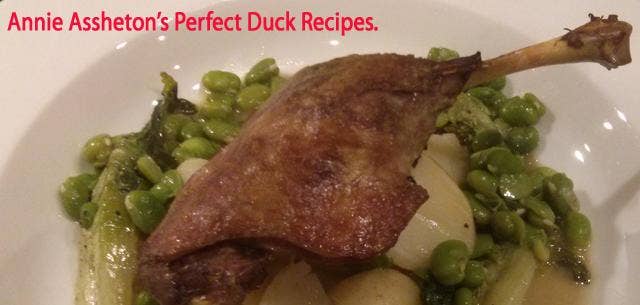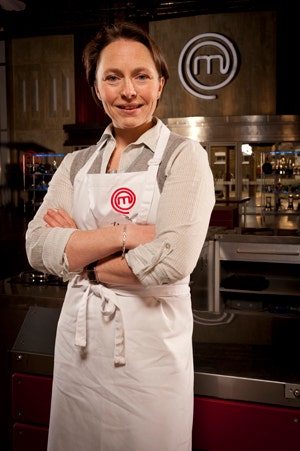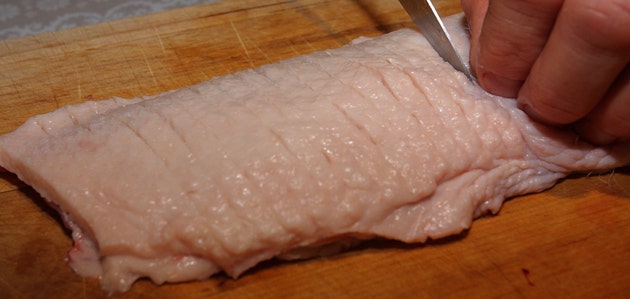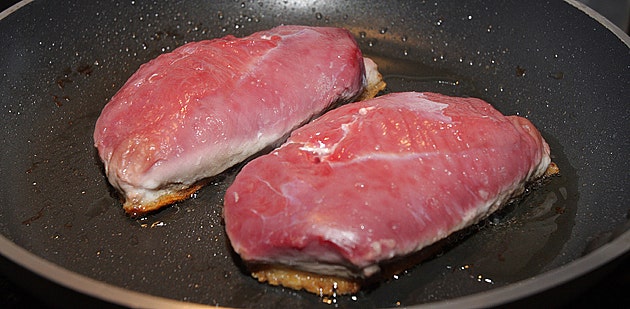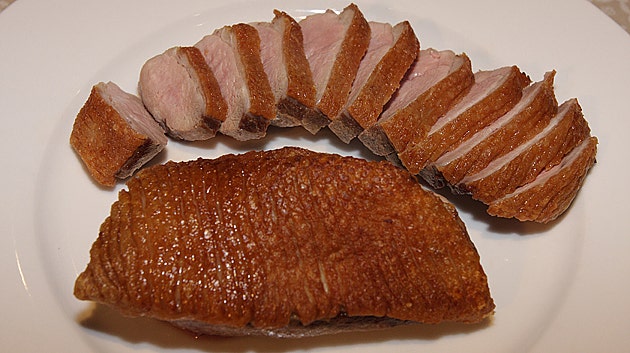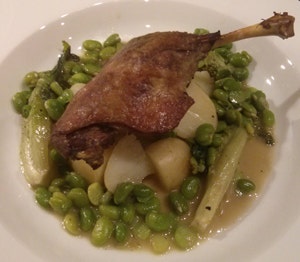My daughter often likes to remind me that she beat me in MasterChef. In fact Milly, who is now 11, did win MasterChef whilst I only came 6th - but hers was a slightly lower profile competition run by her school. Milly and her cookery partner progressed through various rounds before being selected along with three other couples for the final in which they were asked to cook a main course and pudding of their own design for six people. Their dishes were judged by a local professional chef and a culinary-minded teacher who gave critical feedback worthy of John and Gregg to all of the finalists.
After a bit of practise Milly, then only just 10, and her friend Emily amazed me with their ability to produce extremely professional looking plates of food that were not only beautifully presented but perfectly cooked. When they were coming up with ideas for their menu, duck quickly emerged as a favourite for them both and they decided to make an oriental inspired dish of roast duck breast with rice and an orange and star anise-spiced sauce.
My heart initially sank when they announced this decision because I have too often been given badly-cooked duck breast; either overdone or, just as frequently, practically raw and in both cases tough with flabby skin. It seemed to me to be a difficult dish for two young and inexperienced cooks to get right.
However, having shared my favourite technique for cooking these lovely plump cushions of meat, I realised that there is no reason why everyone, including children, shouldn’t be able to present them perfectly every time; you just need to know how.
Cooking Perfect Duck Breasts A few years ago, when received wisdom dictated that duck breasts should be seared skin side down in a very hot pan to crisp up the skin, I read a fascinating recipe that suggested putting them (still skin side down) in a completely cold pan, over a medium heat and allowing the fat to render out slowly from under the skin (this takes at least ten minutes). They were then turned over and put into the oven (at 180°C) for five minutes before being rested in a warm place for ten minutes.
Having tried this technique at the time, I now never cook duck breasts any other way and can be completely confident that the skin will be golden and crispy and that the flesh will be beautifully pink all the way through thanks to the slightly longer but more gentle cooking process.
The key to success with this is not just the timing and temperature but also the scoring. It is very important that the skin should be scored very finely (a properly sharp knife is essential for this) with the cuts reaching all the way from one edge of the skin to the other. This will prevent the outer edges of the skin contracting when it gets hot, thereby lifting the inner section of the breast away from the heat so that the fat won’t render out efficiently and the skin won’t crisp.
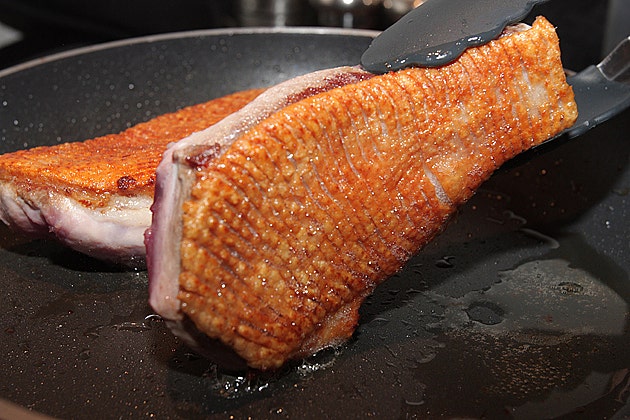
There is nothing more frustrating than turning over your duck breasts in anticipation to find that the temptingly golden outside edge surrounds a pale and soft central region instead of uniform crispness. So be sure to score all the way to the very edges to avoid disappointment.
Duck and Celeriac Puree There are so many ways of enjoying your perfectly cooked duck breasts it’s hard to know where to begin but duck goes beautifully with celeriac, another of my very favourite vegetables and one which is readily available locally throughout the winter and one which makes a super-rich and indulgent puree.
Peel and cube half a celeriac and put it in a non-stick pan with a generous ounce of butter. Put it over a medium heat with a lid on, giving it a shake or stir fairly frequently. After about ten minutes - by which time the cubes should have started to soften a little - add a very generous dollop of double cream and a good pinch of salt. A sprig of thyme goes well too.
Put the lid back on and leave to cook until it’s all completely soft by which time it might well look a bit scary; sometimes at this point the cream and butter can look rather curdled but fear not, a quick blitz with a hand held blender (remove the thyme sprig first) will bring the mixture together into a beautifully smooth puree which might look pale and only slightly interesting but on tasting reveals itself to be unashamedly decadent.
Not only does this puree taste delectable but it is also incredibly well behaved. You can make it well in advance and reheat it when needed; it even freezes beautifully. Be warned, a little goes a long way!
Confit Duck Legs So far I have only mentioned duck breasts but of course the legs are wonderful too. Unlike some smaller birds their legs are large enough to be stars of their own dishes but I tend to cook them differently to the breasts to ensure that they are tender and succulent. Of course a classic confit is the ultimate treatment, with almost crackling like crispy skin blanketing the softest possible meat underneath.
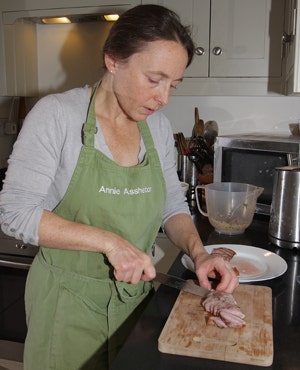 This is not something to be undertaken when you are short of time and a degree of patience is required but before you reject the idea as impractical do bear in mind that there is very little ‘hands on’ time, there are no tricky or complicated techniques involved and the whole point of a confit is that it will be preserved so you can make it very well in advance of when you need it. For entertaining this is ideal; the legs can be ready and waiting on a roasting tray and all you need to do is pop them through the oven when you’re ready.
This is not something to be undertaken when you are short of time and a degree of patience is required but before you reject the idea as impractical do bear in mind that there is very little ‘hands on’ time, there are no tricky or complicated techniques involved and the whole point of a confit is that it will be preserved so you can make it very well in advance of when you need it. For entertaining this is ideal; the legs can be ready and waiting on a roasting tray and all you need to do is pop them through the oven when you’re ready.
The first stage of the procedure is to cure the duck legs in salt which is not only about preservation but also concentrates the flavour.
Sprinkle the base of a non-metallic dish with rock salt before adding the duck legs in a single layer and sprinkling with more rock salt. You can pop in some herbs and spices at this stage if you like; I normally add juniper berries, thyme and bay leaves. Then you simply cover the dish with cling film and leave it overnight.
In the morning, rinse the legs very thoroughly indeed before drying them off just as carefully. The legs then need to be put in a large oven proof pan (cast iron is ideal) and completely covered with duck fat. Your fat will be solid so just add lots to the pan and allow it to melt then keep adding more until the legs are submerged. Four duck legs will require around 800g fat and whilst one might blanch at the idea of all that grease, thanks to the alchemy that is the confit process the resulting meat will in fact be lower in fat than if it had been simply roasted.
Bring the whole thing barely to a simmer (there should be practically no bubbles reaching the surface) and then put it in the oven at 130°C for 2½ hours by which time the meat should be so tender you have to handle the legs very carefully to keep them intact. Once cooled, put the legs into a Tupperware container and cover them completely, again, with the cooking fat along with any aromatics you added to the pot.
When you are ready to use them you just need to scrape off the fat and put the legs in a very hot oven for ten minutes to heat through and crisp up the skin. The duck fat, by the way, can be reused several times so the whole thing is much less extravagant than you might think.
Braised Duck Legs There really is nothing that can compare to duck confit, but if you need a same day and slightly simpler solution the recipe below is a very close second best. It is a technique that I use for lots of game birds (I touched on it last time for grouse) but with duck it really comes into its own and I’m always amazed at the result. Both this and the classic confit can be used in so many different ways: with creamy mashed potato and green beans; on a braise of flageolet beans with bacon all finished with a dollop of cream; with spiced and slow cooked red cabbage; with puy lentils and creamed savoy cabbage with chestnuts; the list is endless.
I have chosen to accompany it here with a lovely braise of lettuce and vegetables for a lighter combination. I have used little gem lettuce because it holds together nicely but if you have other non-bitter leaves that need using up just shred or tear them and wilt them in the butter.
Recipe: Braised duck legs with garden vegetables
For the braised duck legs 4 duck legs 1 onion 1 carrot 1 stick celery Sprig thyme and/or 1 bay leaf Water/chicken stock to cover
For the braised vegetables 2 little gem lettuces 50g butter 200ml stock (you can use the braising liquor from the duck) 250g frozen (or freshly shelled) peas 250g broad beans, blanched and podded 1 tbsp chopped mint 500g small new potatoes
Method First braise the duck legs. Put them in a large pan with the onion, carrot, celery and herbs and add enough water or stock to cover. Bring just up to the boil and then cover the pan and simmer very gently for two hours. Allow the legs to cool, in the stock if possible, then remove and leave in the fridge until you need them. Strain the braising liquor, reserve enough to use for the vegetables, and reduce the rest before cooling, freezing and saving for another day.
To make the braised vegetables, first cut the potatoes into equal size pieces and boil in salted water for ten minutes or until just tender. Meanwhile, trim the lettuces and cut each one lengthways into six wedges, discarding the loose outer leaves. Melt half the butter in a pan over a medium heat, add the lettuces and cook for one or two minutes on each side until they begin to colour and wilt. Turn up the heat a bit, add the peas and stock and bring to the boil. Simmer for three minutes until the peas are softened. Stir through the rest of the butter and the broad beans and agitate the pan so the butter and stock emulsify. Strain the potatoes, add them to the pan and finally stir through the chopped mint.
While the vegetables are cooking arrange the duck legs on a shallow roasting tray and put in a very hot oven for ten minutes until the skin is lovely and crisp.
Share the potatoes, vegetables and buttery sauce between your four plates and sit a duck leg on top of each.
2015-12-08 14:52:12
58 view(s) 

